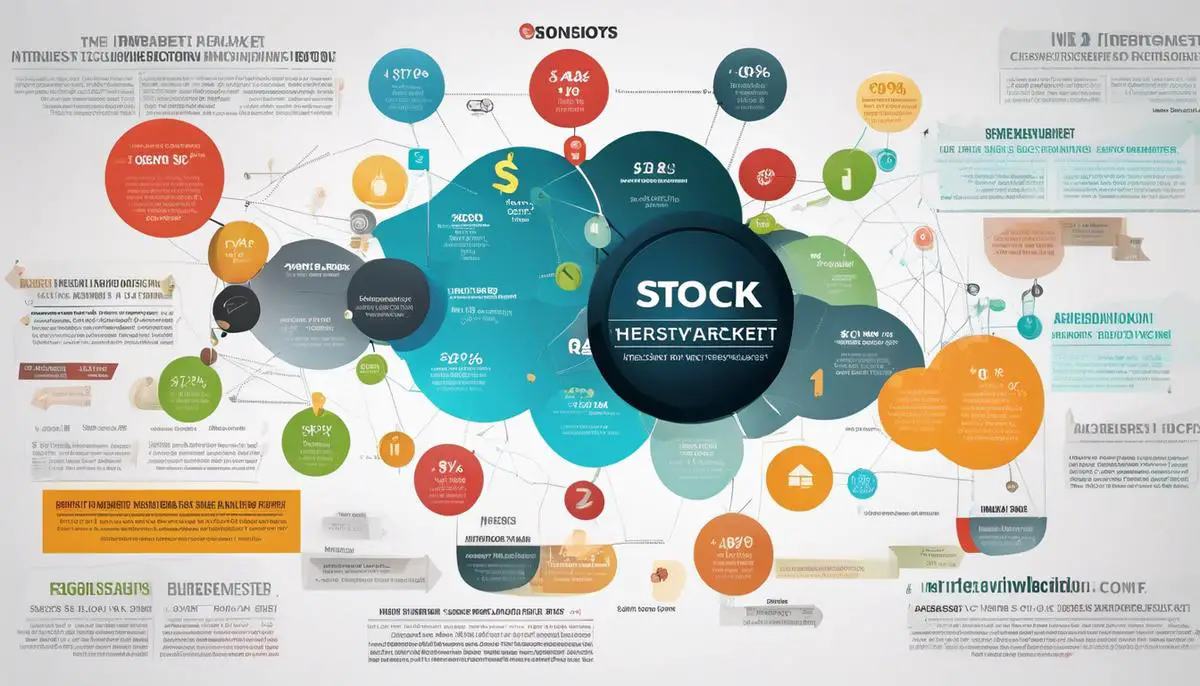Welcome to the invigorating world of stock market trading, a realm where the confluence of economic vigor and individual acumen paves the path to financial opportunity. As we embark on this elucidative journey to decode the intricacies of the marketplace, we ground ourselves in the study of market fundamentals. These are not mere data points but the very heartbeat of the financial ecosystem, pulsating with each report on economic indicators, interest rate adjustment, and corporate earnings release. By peeling back the layers, we can grasp the delicate interplay of forces that influence stock prices and set the stage for informed trading decisions. To navigate this complex terrain, we must also become adept at executing various types of stock trades, leveraging their strategic potential to optimize our market engagement. Sharpening our analytical lens to discern stock market trends enables us to ride the waves of change with informed precision. And anchoring our venture into trading with robust risk management techniques ensures that our sails are always adjusted to the winds of market volatility, charting a course towards sustainable growth and portfolio resilience.
Understanding Market Fundamentals
The Underlying Engines of the Stock Market
When delving into the realm of the stock market, savvy entrepreneurs and investors alike understand that its movement is not random whimsy. Far from it, the stock market is a complex entity, driven by a series of interconnected factors that transcend simple supply and demand. The key drivers are multifaceted, but by distilling them down to their essence, industry leaders can anticipate trends and innovate strategically.
To begin with, the stock market is fundamentally influenced by economic indicators. These include critical data points such as GDP growth rates, unemployment figures, and inflation. When the economy is booming, with high employment and robust spending, confidence ascends, investors become more bullish, and stock prices generally follow suit. Conversely, downturns in these indicators can prompt a sell-off.
Earnings reports serve as a report card for companies, offering insights into their performance and profitability. The anticipation of these financial disclosures often causes noticeable fluctuations in stock prices. Companies that consistently beat earnings expectations tend to see their stock values surge, as they affirm the confidence of investors looking for tangible results.
Interest rates set by the Federal Reserve are pivotal as well. Lower rates make borrowing cheaper, facilitating business growth and expansion—propelling stock prices upward. Higher rates can have the opposite effect, potentially cooling down an overheated market.
Furthermore, the stock market is perpetually swayed by news—both domestic and international. Political stability, regulatory changes, and geopolitical events can have immediate and pronounced effects on market sentiment. A thumb on the pulse of current events is a must for any sharp market participant.
Innovation and competition shape the market comprehensively. Disruptive technologies and services that fill market voids can rapidly shift the landscape. Companies that fail to adapt can quickly find their market share—and consequently, their stock value—erode.
Additionally, market sentiment, although intangible, wields considerable influence. Investor psychology is a massive driving force; fear and greed can inflate bubbles or trigger crashes. Seasoned entrepreneurs with a deep understanding that emotion often trumps logic in investments can navigate these choppy waters more effectively.
Finally, the vanguard of any thriving portfolio is diversification. By spreading investments across various sectors and asset classes, one can mitigate the risks inherent to stock market volatility.
In summary, the stock market is driven by a sophisticated array of factors where economic health, company performance, monetary policy, news, innovation, and psychological sentiment play leading roles. Understanding and integrating these drivers is the cornerstone of any successful investment strategy. For the proactive and perceptive business maven, the stock market is not a gamble—it’s a calculated field of opportunity, ready to be seized by those who dare to look beyond the mere ebb and flow of stock prices.

Types of Stock Trades
Navigating the world of trading requires a keen sense of timing and a deep understanding of market mechanics beyond the foundational factors such as economic indicators, earnings reports, and interest rates. If you’re looking to execute winning trades, you need razor-sharp strategies, tactical acumen, and a few tricks up your sleeve.
To begin with, let’s discuss technical analysis – a trader’s bread and butter. Technical traders rely on price patterns, charting tools, and various indicators such as moving averages, RSI (Relative Strength Index), and Bollinger Bands to predict future market movements. Mastery of these tools allows traders to pinpoint optimal entry and exit points, thereby maximizing profits and limiting losses.
Another critical element is trend analysis. Identifying whether the market is bullish or bearish can inform whether to long or short a stock. Executing trades in sync with the market’s overall direction can significantly increase the odds of success. Utilizing tools like Fibonacci retracement or the Elliott Wave Theory can help in discerning the health and potential direction of market trends.
Let’s not forget the importance of liquidity and trading volume. Stocks that trade in high volumes tend to have tighter bid-ask spreads, making them more favorable for quick trades. They are also less prone to price manipulation, which reduces trading risks. Savvy traders always keep an eye on the volume as an indicator of a stock’s stability and the market’s appetite for that security.
Risk management should be the cornerstone of all trading activities. Setting stop-loss orders and taking profits at predetermined levels ensures discipline and guards against the emotional pitfalls of trading.
Position sizing is another aspect where the pros excel; never risk more on a single trade than you can afford to lose. Keep your bets sized correctly and live to trade another day.
Last but not least, always stay informed with a finger on the pulse of technological advancements and global economic shifts. Exploit tools like algorithmic and high-frequency trading if they’re within your reach. These can provide a competitive edge by leveraging the power of sophisticated computer algorithms and lightning-fast execution speeds.
In essence, successful trading is as much an art as it is a science. It demands constant learning, adaptability, and a relentless quest to find an edge in an ever-evolving marketplace. Execute these strategies with precision, and you’ll be well on your way to securing winning trades in the stock market.

Analyzing Stock Market Trends
Harnessing Social Listening for Market Trend Identification
In an era where consumer behavior is king, social listening has ascended to be a crucial tool for savvy entrepreneurs aiming at spotting profitable market trends. Social media trends, influencer opinions, and online consumer feedback are treasure troves of information waiting to be tapped. These digital platforms provide real-time data that can signal shifts in consumer interests and emerging preferences, leading to actionable insights for businesses.
Understanding Demographic Shifts
Demographic analysis isn’t just about numbers; it’s a narrative of changing consumer landscapes. As populations age, birth rates fluctuate, or immigration patterns shift, so do market opportunities. Forward-thinking businesses analyze these demographic shifts to forecast demand for products and services, catering to a changing consumer base before competitors catch wind.
Analyzing Supply Chain Dynamics
An often underrated indicator of market trends is the global supply chain. Variations in supply chain dynamics such as material costs, labor disputes, or shipping bottlenecks can foreshadow shifts in market prices and product availability. A deep dive into supply chain logistics can uncover nascent market trends and provide a competitive advantage to those who can swiftly adapt their business models accordingly.
Exploiting Niche Markets Through Micro-Trends
While macro-trends paint the big picture, micro-trends are where the astute entrepreneur finds gold. Identifying and exploiting niche markets through micro-trends involves understanding the unique and specific needs of customer segments that are often overlooked. Products or services that cater to these niches can create loyal customer bases and generate significant profit margins.
Merging Sustainability with Profitability
Sustainability is no longer just a buzzword – it’s a market force. Consumers are increasingly making purchasing decisions based on a brand’s environmental and social impact. Leveraging this trend by innovating sustainable practices and products not only contributes to corporate social responsibility but also opens doors to a rapidly growing market segment keen on supporting eco-friendly businesses.
Embracing the Gig Economy and Freelance Market
The rise of the gig economy has fundamentally altered the employment landscape. This shift has implications for product and service demand, as freelancers and contractors have distinct needs compared to traditional employees. Businesses that recognize and cater to the freelance market stand to benefit from this increasingly prevalent economic trend.
Taking Account of Regulatory Changes
Regulatory frameworks shape markets. Businesses that stay ahead of new laws, standards, and regulations can quickly pivot, adapt, and often capitalize on the changes that might cripple less-prepared competitors. Monitoring legislative developments is thus a key aspect of trend-spotting that can yield profitable insights.
In conclusion, spotting profitable market trends is an art that demands vigilance, agility, and an understanding of the diverse elements that affect market dynamics. Entrepreneurs must cultivate a panoramic view, not just focusing on financial metrics but also embracing a broader perspective encompassing social behaviors, demographic shifts, supply chain indicators, and regulatory landscapes. The ability to anticipate and innovate in line with these shifts is what delineates a market leader from the rest of the pack.

Risk Management in Trading
Steering Clear of Emotional Trading Traps
An often-overlooked aspect when protecting a portfolio is the psychological element of trading. Emotional biases can skew rational decision-making, leading to less than optimal portfolio performance. Unchecked emotions such as greed or fear during market highs and lows respectively, can result in the classic pitfalls of buying high and selling low. This is where a disciplined approach to trading, based on a well-thought-out plan, comes into play. Establishing a set of trading rules or algorithms that dictate when to buy or sell can insulate one’s decisions from emotional influence, ensuring consistency in strategy execution.
Utilizing Options for Hedging
Expanding on tactics to shield investments, options trading is a sophisticated method used to hedge against market downturns and volatile conditions. Utilizing tools like protective puts or covered calls can offer downside protection or income generation, respectively. While options are a complex instrument that require a strong grasp of financial mechanics, they represent an invaluable resource for those seeking to enhance their portfolio defense strategies.
Rebalancing for Risk Control
Rebalancing is a critical yet simple mechanism to maintain risk levels in check. As market movements can alter the initial weightings of assets in a portfolio, rebalancing ensures that these weightings stay aligned with one’s risk tolerance and investment goals. By periodically selling overperforming assets to purchase underperforming ones, rebalancing also inadvertently embeds a ‘buy low, sell high’ discipline into ones’ investment approach.
Eyes on the Political Climate
Beyond the realm of markets, an astute investor monitors the political climate for indications of policy shifts that may affect investments. Trade policies, tax reforms, and changes in government regulations can have disproportionate effects on different sectors of the economy. A proactive approach entails adjusting investment strategies to anticipate such policy-driven shifts rather than reacting post-facto.
Incorporating Alternative Investments
To further disease-proof a portfolio, consider incorporating alternative investments such as commodities, real estate, or private equity. Alternatives often exhibit low correlation with traditional equity and bond markets, providing a dampening effect on portfolio volatility. This can be particularly beneficial in times of market distress, where traditional asset classes might concurrently experience downturns.
Leveraging Professional Expertise
For the investor who recognizes the limits of their expertise, enlisting professional financial advice can be a tactical move. Financial advisors can offer insights into aspects of portfolio protection that one may not be versed in, such as estate planning, tax-optimized investing, or insurance products that can offer additional layers of protection for one’s assets.
Conclusion
In conclusion, fortifying a portfolio extends beyond classic diversification or keeping abreast with financial news. It demands a multifaceted strategy that includes emotional discipline, sophisticated hedging techniques, perpetual portfolio rebalancing, a keen eye on the political landscape, incorporation of alternative investments, and perhaps most importantly, the humility to seek professional expertise when necessary. By doing so, one ensures that their portfolio isn’t just surviving in a dynamic financial ecosystem, but thriving, ready to capitalize on the next wave of market opportunities.

Photo by john_thng on Unsplash
As we draw to a close on our exploratory passage through the dynamic landscape of stock trading, it’s clear that the pursuit of market mastery is a continual learning process. Embracing the complexities of analyzing stock market trends has empowered us with the foresight to pinpoint burgeoning opportunities. Our foray into the strategic application of diverse stock trades serves as an arsenal in our quest for capital gains. Moreover, the diligent application of risk management principles stands as a bulwark against the unpredictable tides of market fluctuations, ensuring the longevity and health of our investments. Armed with these insights, we stand at the threshold of an ever-evolving marketplace, ready to engage with confidence and a reinforced commitment to the art of trading. Through disciplined application and perpetual education, the world of stock market trading is not just accessible, but ripe with potential for those who dare to delve deep and harness its profound possibilities.

